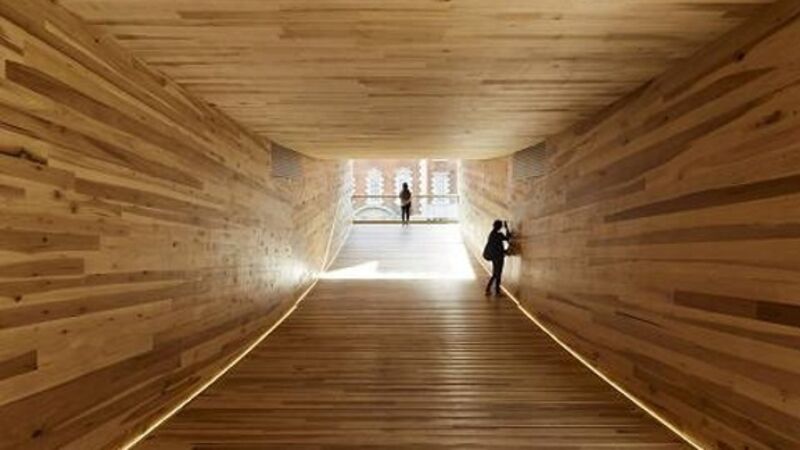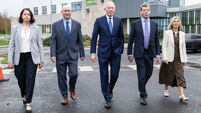Innovative CLT timber to deliver profit boost for forestry sector

By Diarmuid Cohalan
Cross Laminated Timber is a potential game-changer for the Irish timber industry and forestry growers.
It can add considerable value to the estimated 84% of Irish commercial timber made up of soft wood conifers, consisting mainly of Sitka Spruce, Norway spruce, Scots Pine and Douglas Fir.
These are the preferred species for production of Cross Laminated Timber (CLT), the building material capable of competing with concrete and steel.
Historically, timber has been immensely important as a building material, even in primitive times, timber was used for cabin building, boat building and material for small wood bridges. When concrete emerged as a building material in the 18th century, the usage of timber declined, but continued to be used on roofs, doors and windows of houses.
Right through the 19th and 20th century’s, concrete was the main building material and steel the main weight bearing substance.
Austria was the first country in Europe to pioneer CLT development, which has now spread to most other EU countries, including the UK.
The manufacturing/assembly process for CLT is reasonably straightforward, it involves lengths of sawn soft-wood timber kiln-dried to 12% moisture content being placed at right angles in layers of three five or seven, depending on the thickness required.
A special adhesive glue is applied to the surface of the sawn timber — and the pieces of timber are then hydrologically pressed together to form a solid mass of timber with equal weight-bearing capacity to steel and concrete for construction purposes.
This new technology for engineered timber production emerged in the early 1990s.
In comparison with concrete and steel, timber has a much lower carbon foot-print and has much greater aesthetic value in housing accommodation, creating a feel good factor for occupants.
This is becoming increasingly important for a greater number of people who want to live their lives in environmentally friendly accommodation, with the least possible carbon foot-print.
Over the past two decades there has been an increasing movement towards CLT constructed buildings, especially in central and southern Europe and Scandinavian countries, where timber buildings are either constructed solely from timber, or have a layer of masonry on the external walls.
With the rest of the building being constructed from CLT panels.
Some in Britain’s house building industry are now predicting an increasing movement towards timber construction. There is also an increasing acceptance amongst some of Britain’s Architects, including Waugh Thistleton UK and International Engineering Consultants Ramboll, who are involved in high rise building development — that while concrete and steel were the building materials of the 19th and 20th century, timber will be the building material of the 21st century.
This has a significant positive impact for the future demand of saw-log from the commercial grown forests in Ireland. It is also noteworthy that for every three layers of timber used in CLT production, there are two layers of long length timber and one cross layer of short length timber.
This means that CLT production, will not only create additional demand for long length saw-log, but will also create demand for shorter saw-log, normally used as pallet log and stake log.

To date, most large European CLT production facilities are based in Central Europe. The largest Cross Laminated Timber production operations are in Austria with 7 production facilities, Germany with 3, and Switzerland has 2, with smaller facilities in Finland, Norway, Sweden, Italy and Spain.
While timber framed housing construction has been popular in the UK for many years, Britain has only recently engaged with CLT construction, using imported CLT panels from Austria and other European Countries.
CLT building construction in the UK has been hampered by the absence of home produced CLT panels, which meant that all CLT used in the UK had to be imported from Europe.
This situation is now changing, with a number of outside producers moving to the UK to set up CLT manufacturing plants. China National Building Material Company has released plans to build six CLT modular manufacturing plants in Britain, in conjunction with Your Housing Group — a leading UK housing association, in a joint venture worth £2.75bn.
Also, Legal & General, who are a large UK Insurance Company has recently invested heavily in Britain’s first CLT manufacturing plant, which is due to begin mass producing CLT panels in its new factory in Leeds, where it expects to produce 3,000 CLT factory produced housing units a year.
To date, most CLT buildings in the UK are built around London, including Dalston Lane, consisting of 121 accommodation units, and the Cube Building in Hackney which is a 10 storey mixed apartment building, (the highest timber building in the UK).
In 2016, Britain was only 50% sufficient for all categories of home grown timber and 35% sufficient for sawn soft-wood timber. Depending on currency exchange rates post Brexit, this could create a huge opportunity for Irish sawmills to increase exports to the UK, well above 2016 levels of 5.3% of the total UK market for sawn soft-wood.
For CLT, sawn soft-wood has to be kiln-dried to 12% MC — well below the 18%/20% MC for conventional timber. This is set to increase timber shrinkage and add to processing costs.
But the reported €500 per M3 for imported CLT panels in the UK should more than compensate Irish Sawmills for the extra processing cost of premium value timber suitable for CLT production.
Meantime, the failure of the Irish Regularity Authorities for building standards, to see the unique properties of CLT as a fire repellent, is preventing its use in multi-storey buildings here.
And, given the vast scale of the UK market, it is likely, in the short term at least, that Irish sawmills may concentrate in producing kiln-dried timber suitable for CLT production, and focus on exporting to the UK and other European manufacturing outlets.
Either way, if as predicted, the increasing move towards CLT-constructed buildings continues as a popular option in the UK and Europe, forestry growers in Ireland are likely to benefit significantly from the increasing demand for all categories of saw-log.
The inclusion of biomass in the Renewable Heat Scheme announced by Minister Denis Naughten TD in December 2017, is also likely to increase demand for low grade log from forestry thinnings, if used for woodchip.
As a consequence, this will combine to create added value for all categories of saw-log, leading to a positive chain reaction to enhance private forestry growing, by insuring greater demand and higher market returns for all grades of saw-log for private forestry growers in the future.












